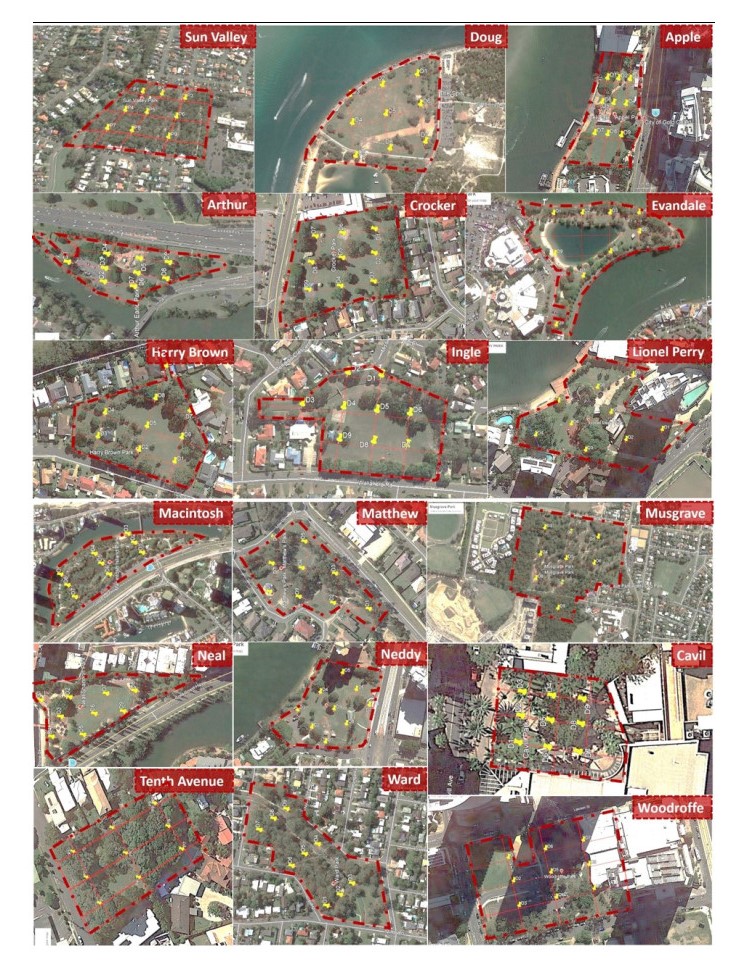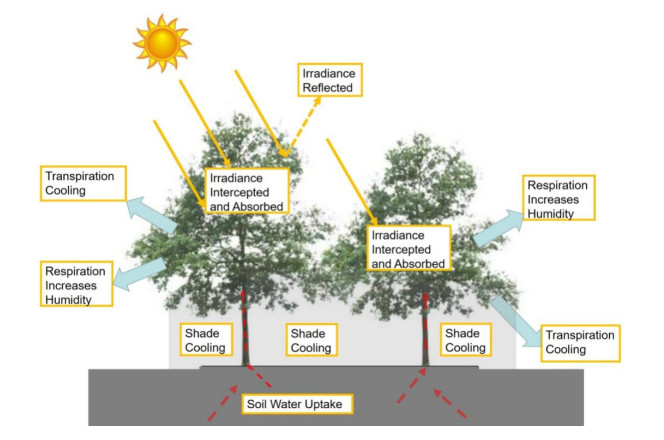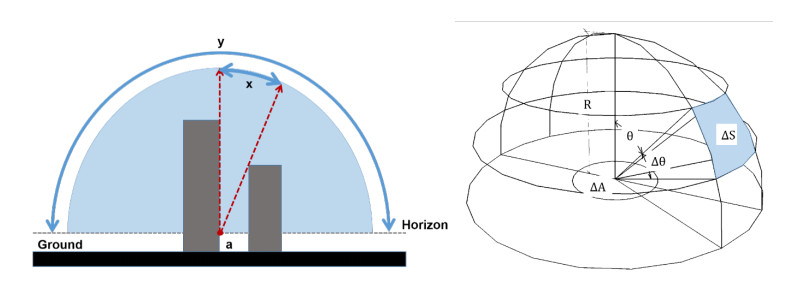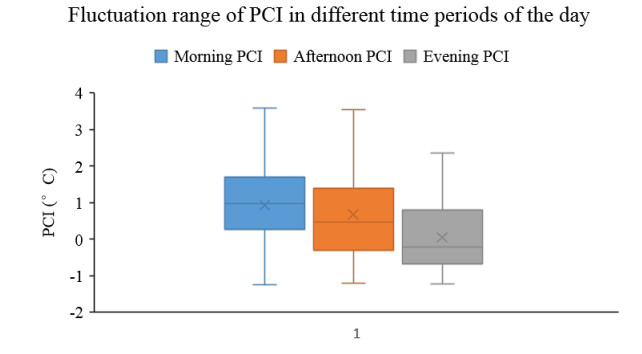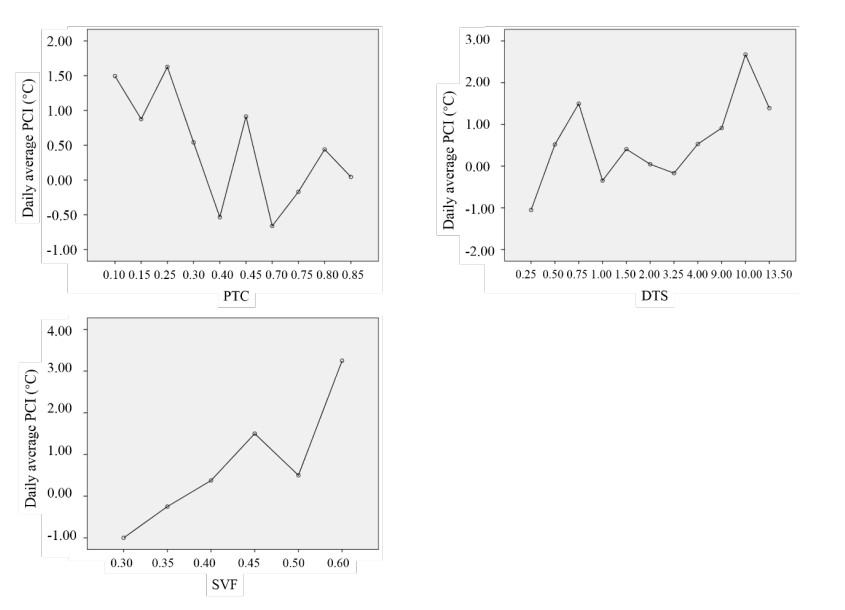Urban parks can help to ameliorate the urban heat island effect. This study measured thermal environments in 18 urban parks in Gold Coast, a coastal subtropical city. In particular, this study categorized and investigated two types of planning factors that may affect the thermal environment in parks: internal factors, including park tree coverage and sky view factor, and external factors, such as distance to the sea. Through physical measurement and analysis of variance, it is found that that the park cooling intensity was affected by both internal and external factors, while their effects varied in different periods of the day. The effect of trees was most significant in the evening. An increase of park tree coverage and a decrease of sky view factor could reduce evening air temperature by around 2 ℃ and 2.5 ℃ respectively. The effect of the sea was more significant in the morning. The park with the shortest distance to the sea could decrease air temperature by more than 2 ℃ in the morning. This study identified the features of thermal environment in coastal subtropical areas and their influential factors; it also provided evidence and guidance for urban planning and design to improve urban thermal environment.
1.
Introduction
There are more than half of global residents inhabiting in cities [1]. This figure is predicted to reach 66% in the middle of this century. In cities, people suffer from serious urban environmental problems; urban heat island (UHI) is one of them, which refers to the phenomenon that the urban areas are usually warmer than their surrounding suburban areas. It has been proved in many studies [2,3,4]. It significantly affects the inhabitability of a city, such as increasing the amount of cooling energy consumption [5], causing poor health condition [6] and thermal discomfort [7]. Due to the continuous global urbanization, increasing number of world population would be affected. Therefore, the urban heat or urban thermal environment is a pressing problem, which needs to be addressed immediately.
To avoid the side effect of UHI, many researchers are investigating methods to mitigate it. The methods include such as increasing urban vegetation spaces, establishing water bodies, and creating more shading for urban areas [8,9,10]. Meanwhile, due to a large proportion of urban lands being used for the construction site which is mostly covered by concrete, asphalt, and cement, urban parks need to play a major role in mitigating urban heat island and improving urban thermal environment.
In response to this need, a variety of studies have been conducted to verify whether parks are cooler than their surrounding areas. It is found that urban parks with grass land surface is nearly 19 ℃ cooler than its surrounding asphalt, and the air temperature above the lawn is more than 1 ℃ lower [11]. Some studies found that green space can reduce temperature by nearly 1 ℃ and the reduction degree depends on its size [8]. The level of reducing temperature is associated to vegetation species, canopy covering, as well as park size and shape [12]. Through studying several campus areas with tree canopies in Taiwan, Lin found that a higher sky view factor (0.8) results in more thermal discomfort in the summer [13]. A field measurement in ten parks in Singapore found that shades are the most effective factor for reducing temperatures, cooler by 10 ℃ at least (48.5–38.4 ℃). One key of shade generation is planting more trees, which proves the significance of trees in UHI mitigation [14].
Parks usually have lower temperatures than their surrounding districts, while high tree coverage could reduce air temperature. Higher land usage creates more shades, which mitigates UHI. That is to say that vegetation, shades, and parks are functional in urban microclimate improvement [15]. A spatial regression model to analyze parks in Beijing center confirmed that water area and index of parks could significantly reduce temperature, while areas of buildings as well as main roads would increase temperature [16]. Parks are indicated to reduce land surface temperature by 7.26 ℃ depending on the land covering materials (Grass or Tree) [17]. An analysis on thermal infrared remote sensing data pointed out that parks with a water area proportion above 30% have more significant temperature reduction performance, and the cooling distance is also farther [18]. Sizes of forest vegetation and their spatial arrangements could cause urban cooling, while cool island composition as well as its surrounding environment can also influence that [19]. A study investigated three parks in Abuja and found a number of park factors in relation to sizes and geometries that influenced park cooling effects [20]. A measurement work at Beijing Olympic Park found that areas with higher vegetation coverage are considerably cooler, and its significance varies in regards with different time periods of the day [21].
Cooling effect of parks creates more thermally comfortable environments for urban dwellers’ recreation, which improves urban thermal environment, and mitigate the negative thermal impact due to UHI. The reviewed studies have confirmed that parks have significant effect on thermal environment adjustment. Their cooling performances result from physical factors, including vegetation, water body, and shades. Cooling levels of parks depend on size, scale, coverage, and distance. Moreover, park can also affect thermal environments of its surrounding areas, for districts closer to a park were measured to be cooler, which has been proved in several studies [11,21,22]. A park’s thermal environment could be also affected by its surroundings, especially when contacting a huge water body. This is more significant in coastal cities where parks are exposed to the sea which has cooling effect. Contrasted with park internal factors such as vegetation and size, how the sea affects a park’s thermal environment, is a question worthy of being investigated.
This paper focuses on parks in a coastal city to explore the impact of influential urban planning factors. The influential factors include that inside and outside the parks. Inside factors are defined as internal factors, which are park tree coverage (PTC) and sky view factor (SVF); outside factor is the external factor, which is distance to the sea (DTS). The overall objectives of this study could be summarized as follows:
● To measure and present data showing the air temperature difference between each park and the reference weather station;
● To define park internal and external factors that would affect thermal environment;
● To analyze how does each factor affect a park’s cooling performances.
2.
Methodology
2.1. Study area description
The measured parks are located in Gold Coast, a subtropical coastal city in Australia. Gold Coast (Figure 1) is a coastal city located on the eastern seaside of Queensland, Australia (28° S, 153° E). It has hot and long summers [23]; hence local residents suffer from long-term thermal stress every year, especially those who have to work in outdoor environments. Monthly recorded maximum temperatures are usually above 35 ℃ (Table 1). As a coastal and subtropical city, urban climate characteristics and thermal environment of Gold Coast have not been well studied and documented. The government, strategically, is using a series of green spaces and urban parks to create a green corridor for the city for better habitability and sustainability. It is imperative to conduct thermal environment research to examine the cooling effect of these urban parks on Gold Coast city and to provide evident direction for government planners and architects to design and manage the urban parks for optimal outcomes.
2.2. Air temperature measurement
There are 18 parks (Figure 2) with different planning factors and geographical locations around Gold Coast selected for air temperature measurement. These parks represent the main open vegetation spaces in urban areas of this city. They align with the coastal areas and serve different communities. All parks are covered by trees in different ratios and locating around the city. As mentioned in the reviewed papers, cooling performances of water body and vegetation are affected by their size, coverage, and distance, which would be analyzed in this study. In this study, the park area is not considerably different, and the size would have little effect on parks’ thermal environment. Therefore, these factors are excluded in this study. Some key thermally relevant planning factors of all parks are listed in the Table 2.
The measurement took place during a period of summertime in the Southern Hemisphere, which spanned from 12/01/2018 to 01/03/2018. Every park was measured in a sunny day from around 10:00 to 20: 00. Air temperature (AT) is engaged as the key data. The maps of all parks showing their boundary as well as measured points are displayed in Figure 3. There are nine points in each park selected for the measurement by using rigid grids in response to the park geometry, plants, and footpath distribution, which reflects the whole physical features of one park. Each point was measured three times a day by a Testo 480 (a digital thermal environmental instrument, around 1.5 m above the land.), which has been proved to be a supportive instrument in outdoor thermal environment studies [25]. The whole day measurement was carried out in the morning (10:00), afternoon (14:00), and evening (17:30). It is ordered from Points 1 to 9 during each timestamp. Each point was measured continuously during a 15 m timestamp. To ensure that the measurement is accurate, the 15 measurement values were calculated in average. Therefore, in total, there is a cluster of 27 (3 times a day at 9 points) measurement data for each park.
2.3. Park cooling intensity
Urban heat island intensity (UHII) is usually engaged in UHI study [26]. UHII means the temperature difference between the urban and the surrounding suburban areas of the city, which evaluates the level of UHI. It is indicated by air temperature or land surface temperature. Park cooling intensity (PCI) is an idea similar with UHII. The cooling performance of one park, the temperature difference between the park and its reference (such as a location outside the park), is defined as PCI in this paper. It is calculated by the park temperature minus that of the reference, shown as ΔT. Griffith Station is selected as the reference, which is due to its neutral location, neither too far nor too close to the sea. PCI is calculated by AT of parks minus that of Griffith. A cooler park has a negative ΔT value, whereas a positive value occurs in a warmer one. A lower ΔT means better cooling performance of one park.
2.4. Internal and external factors
2.4.1. Park tree coverage (internal)
All parks are fully covered by lawns and different proportional trees. Tree coverage is an internal property for each park. It is calculated by the ratio that tree covering area to the park surface area in the satellite image. PTC is used for tree’s effects in environmental adjustment, which is proved by several studies, including Lin and Lin [27], ZhaoWentz and Murray [28], and ArmsonStringer and Ennos [29]. Theoretically, cooling effects of trees result from their physical (shading) and biological (photosynthesis [30] and transpiration [31]) properties, which is illustrated Figure 4.
2.4.2. Distance to the sea (external)
Park thermal performance is also affected by its surrounding environment. The sea, a huge water body to the east of all parks, is a natural conditioner influencing them thermally. Water has also been proved to have certain cooling effect in several studies. A measurement has proved that river bank area is nearly 1 ℃ cooler than its nearby areas [9]. A study from Shanghai found out that cooling distance of water body is around 740 m [32]. A study from Valencia pointed out that water surface can cool down both its situated and surrounded environments [33]. Distance is a factor affecting object cooling effect. As all parks are located in difference distances away from the sea, distance to the sea is used as an external factor.
2.4.3. Sky view factor (SVF, internal)
SVF is another internal factor of all parks. It refers the ratio of sky that could be witnessed at one specific location [34]. It is valued from 0 to 1, which represents total free spaces. For a more clear understanding, the calculation of SVF is explained in Figure 5 and Eq 1 [10].
In this study, parks are mostly covered by trees. A denser tree-covered park has less openness. So SVF values are generally negatively related to PTC. Low SVF values, especially in the areas covered by vegetation, have more significant effects on thermal environment. Zhang Goulu et al. [35] found that reducing SVF from 0.9 to 0.1 at tree covering areas can reduce mean radiant temperature by approximately 15 ℃. LinMatzarakis and Hwang [13] found out that a SVF value of 0.8 (high) is the key cause of thermal discomforts in Taiwan. Hien and Jusuf [36] confirmed that trees can decrease air temperature by nearly 1 ℃ if SVF reduces from 1 to 0.1. Hence it could be deduced that the effect of PTC is opposite with that of SVF.
SVF refers the property of one location, which is measured at each point of a park. In total, there are 9 (points)*18 (parks). The SVF is measured using fisheye lens camera and the value is calculated by using Winscanopy software.
2.5. Analysis of variance
Analysis of Variance (ANOVA) is a combined of statistical model, which is used to analyze the difference among group means in a sample. In this study, park thermal environment data were analyzed in ANOVA to find their correlation with internal and external factors.
3.
Results
3.1. General illustration of measured park data
Figure 6 shows the air temperature fluctuation of all parks during the measurement periods. As to the measurement time in Figure 6, the three boxplots refer morning, afternoon, and evening respectively. There were considerable differences of temperature among them, which ranged from approximately 20 to 40 ℃, due to the daily weather condition differences among the measurement days. Nevertheless, all collected data had a common tendency of change, decreasing during the day. It can be seen from Figure 6 that parks had higher temperature in the morning, relatively lower in the afternoon, and the lowest in the evening.
Figure 7 illustrates the cooling intensity of all parks during the all measurment periods. Due to the variation of park properties, their cooling intensities changed irregularly and widely (from nearly −2 ℃ to more than 4 ℃). Cooling intensities of all parks maintained close to 0 ℃ in the evening despite they jumped remarkably during the day. In other words, park cooling effect is more significant in the evening.
3.2. Effect of each factor on park cooling intensity on the whole day
The data of daily average PCI values were input into SPSS for ANOVA with their internal and external factors. It can be seen from Table 3, that trees do not affect daily average PCI significantly, due to the significance levels of PTC and SVF generally higher than 0.05. The sea has significant effect. Nevertheless, the Mean Plots (Figure 8) have illustrated their overall tendancy, which has some relevance. Figure 8 illustrates the Mean Plots showing the change trend and degree of PCI in regards to its affecting factor value increase. Daily average PCI is negatively correlated to PTC, while it shows increasing trends with the increases of DTS and SVF. The change of PTC, DTS, and SVF can cause mean air temperature variations of approximately 2.5 ℃, 3 ℃, and 4 ℃ respectively. To find their exact correlation, they are further analysed in regards to different periods of the day.
3.3. Effect of PTC on different periods of the day
The result of Homogeneity Test of Variance (HTV) shows that the P-values of PTC effect on PCI in the morning (0.496), afternoon (0.370), and evening (0.681) are all higher than 0.05; therefore, they are suitbale for ANOVA. Data of PCI values in different time periods were input into SPSS for ANOVA with PTC. The outputs are shown in Table 4 and Table 5. It can be seen from Table 4 that the P-value is 0.863, 0.129, and 0.050 for the morning, afternoon, and evening, respectively. Only the evening P-value is less than 0.05. That is to say, PTC is significantly effective in the evening.
The result is illustrated in Table 5 showing further least significant difference analysis (LSD). For simplifying the illustration, only data with significant P-value (less than 0.05) are shown in Table 5 while a full exhibition of all day LSD is attached in the appendix. PCI is generally negatively correlated to PTC and clearer correlations are found in the evening. Table 5 shows the change trend and degree of PCI with regards to PTC increase in different time periods of the day. In the afternoon, an increasing the PTC from 0.15 to 0.75 causes a decrease of afternoon PCI of more than 2 ℃ (P-value = 0.048). This is also significant in the evening (P-value = 0.018), decreasing by around 1.6 ℃.
3.4. Effect of DTS
The result of HTV shows that the P-values of DTS effect on PCI in the morning (0.479), afternoon (0.251), and evening (0.077) are all higher than 0.05, so they are suitbale for ANOVA. Data of PCI values in different time periods were input into SPSS for ANOVA with DTS. The output is shown in the Tables 6 and 7. It can be seen from Table 6 that only the morning P-value is less than 0.05. That is to say, DTS has significant correlation with PCI in the morning.
Due to the fact that the sea has more significant effect in the morning, a further detailed analysis was processed in Table 7 which shows that the farthest location is more than 2 ℃ warmer than the closest one (P-value = 0.004).
3.5. Effect of SVF
The result of HTV shows that the P-values of DTS effect on PCI in the morning (0.432), afternoon (0.299), and evening (0.611) are all higher than 0.05, hence they are suitbale for ANOVA. Data of PCI values in different time periods were input into SPSS for ANOVA with SVF. The outputs are shown in the Table 8. It can be seen from Table 8 that P-values of evening is less than 0.05. That is to say, SVF has significant correlation with PCI in the evening only.
A detailed analysis of evening SVF effect is processed using LSD (Table 9), which shows that decreasing SVF could result in a temperature reduction of around 2.5 ℃.
4.
Analysis and discussion
Vegetation spaces and water bodies have pronounced cooling effects for urban environments. This phenomenon has been broadly studied by many researchers, including Oke [37], Chen and Wong [38], and ChangLi and Chang [39]. Their influential levels are varying for size, coverage, distance etc. This study looked at cooling intensity of parks distributed around the city and their affecting factors. The results indicate that trees’ influence is more significant in the evening, but the sea has a stronger effect during the day. In the morning, the tree cooling intensity is minimal, with minimal temperature difference and a high significance value being observed; during the afternoon and evening, tree cooling intensities are approximately 2 ℃ (P-value = 0.048) and 1.6 ℃ (P-value = 0.018) respectively with lower significance values. In the contrary, the sea cooling intensity in the morning is more than 2 ℃ (P-value = 0.004). It nearly has no effect in the evening (P-value = 0.266).
PTC is negatively correlated with PCI generally. This result is in line with DoickPeace and Hutchings [40], BowlerBuyung-AliKnight et al. [8], Hathway and Sharples [9], and KongYinWang et al. [19]. Trees can reduce environmental temperatures through evapotranspiration and shading. This study has shown that PCI has reduction trend as the PTC rise, which points out that the trees have evident cooling effect. Sun [41] has proved the negative correlation between vegetation coverage and street temperature. A similar result was discovered by WengLu and Schubring [42], ChenZhaoLi et al. [43], Buyantuyev and Wu [44], ZhouHuang and Cadenasso [45] etc.
Meanwhile, its impacts vary at different periods of the day. The cooling effect during the evening is more significant than morning and afternoon. A same result is also found by Jauregui [22], Yokobori and Ohta [46], SunBrazelChow et al. [47], and YanWu and Dong [21]. This indicates that trees have other properties of cooling in addition to evapotranspiration. These properties are even stronger than evapotranspiration and shading.
SVF is positively correlated with PCI, which is caused by the effect of the tree as well. This is proved by many researchers. Hien and Jusuf [36], based on their field measurements, found that daytime air temperature can be reduced by around 1 ℃ when the SVF is decreased from 1.0 to approximately 0.1 by trees. LinTsaiHwang et al. [48] used area-average SVF as the index, indicating that park usage may reduce from 0.16 to 0.01 people/m2 if the SVF value rises from 0.35 to 0.6, which means that people prefer low-SVF vegetation areas. Ahmadi VenhariTenpierik and Taleghani [49] confirmed the significant correlation between SVF and physiological equivalent temperature (PET); through physical measurement and simulation in Isfahan, a value difference of 10.2 ℃ was found.
In addition, park cooling intensity is also affected by its external environment. Distance to the sea is significantly correlated to PCI as well, and its effect varies in different periods of the day, which is rarely investigated in previous studies. A park closer to the sea (with lower DTS value) is cooler than the farther ones. This is caused by the water body physical property. The method by which the sea cools its contacted coastal areas is a process that has been explained in physics [50]. During the daytime, the land is warmed more quickly than the sea water, warming the land surface air. Warm air from the land rises and moves out to the sea, which creates a circular current, resulting land cooling. In contrast, an opposite process occurs in the night, for land cools faster than the sea. As a result, on the ground, sea breezes blow from the sea during the day but the breeze blows from land to the sea in the night. With the continuous air exchange of various temperatures, coastal land temperatures are considerably affected by the sea. The sea breeze is also a branch of convection in physics. It is significant in the morning but it has little influence in the evening. This results from the sea breeze natural properties. The sea breeze cools down the land surface during the day through air exchange. An opposite process occurs after sun fall; hence the sea does not show significant cooling in the evening. This is the reason that evening has insignificant cooling effect from the sea. This phenomenon was proved by TheeuwesSolcerová and Steeneveld [51], YuGuo and Sun [52], and Du [53]. Their studies show that the cooling effect of water body mostly occurs during the day. They approved that the result in this study that DTS has no effect on PCI in the evening is correct and was found by some researchers in similar fields.
5.
Conclusion
This study investigated the internal and external factors of parks affecting their cooling intensity to mitigate UHI. From the ANOVA results, it is found that parks have certain cooling effects in regards to their physical features. This is influenced by a variety of factors and varies for different time periods of the day. Trees are able to decrease park air temperature by nearly 2.5 ℃ for the whole day time through coverage rise; its greatest effect is observed in the evening, reducing PCI by more than 2 ℃ (P-value = 0.018). Effects of trees are also emerged in SVF, reducing evening PCI by 2.5 ℃ (P-value = 0.010). Impact of the sea is greater than the tree for the whole daytime. The park farthest to the sea is about 2 ℃ warmer than the closest one (P-value = 0.004); the most significant influential period is morning.
This study provides the ability evidence of trees and the sea on stabilizing the fluctuation of park cooling intensity, which shows the contributions of planting denser trees and locating closer to the sea as efficient methods for improving urban thermal environment as well as mitigating UHI in coastal cities. Large difference in cooling intensity of the studied factors exists in time period variation of the day. Admittedly, some limitations exist for this study. One of the limitations is that this study focused on three influential factors while excluding other factors or indicators such as trees leaves or types, and parks orientations in relation to dominant wind. It is necessary to include factors in future studies to find more compounding relationships.
Acknowledgments
This project is supported by Griffith School of Environment Research Fund.
Conflict of interest
The authors declare no conflict of interest.
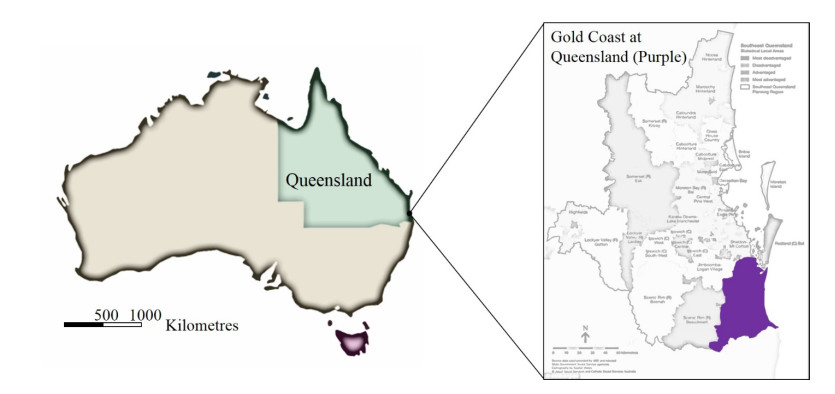









 DownLoad:
DownLoad:

